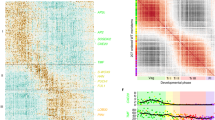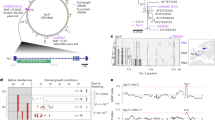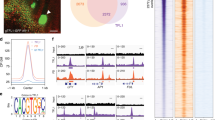Abstract
The initiation of flowering in plants is controlled by environmental and endogenous signals1,2. Molecular analysis of this process in Arabidopsis thaliana indicates that environmental control is exerted through the photoperiod and vernalization pathways, whereas endogenous signals regulate the autonomous and gibberellin pathways. The vernalization and autonomous pathways converge on the negative regulation of FLC3,4, a gene encoding a MADS-box protein that inhibits flowering3,4. We cloned FVE, a component of the autonomous pathway that encodes AtMSI4, a putative retinoblastoma-associated protein. FVE interacted with retinoblastoma protein in immunoprecipitation assays, and FLC chromatin was enriched in acetylated histones in fve mutants. We conclude that FVE participates in a protein complex repressing FLC transcription through a histone deacetylation mechanism. Our data provide genetic evidence of a new developmental function of these conserved proteins and identify a new genetic mechanism in the regulation of flowering.
This is a preview of subscription content, access via your institution
Access options
Subscribe to this journal
Receive 12 print issues and online access
$259.00 per year
only $21.58 per issue
Buy this article
- Purchase on SpringerLink
- Instant access to full article PDF
Prices may be subject to local taxes which are calculated during checkout




Similar content being viewed by others
References
Simpson, G.G. & Dean, C. Arabidopsis, the rosetta stone of flowering time?. Science 296, 285–289 (2002).
Koornneef, M., Alonso-Blanco, C., Peeters, A.J.M. & Soppe, W. Genetic control of flowering time in Arabidopsis. Annu. Rev. Plant Physiol. Plant Mol. Biol. 49, 345–370 (1998).
Michaels, S.D. & Amasino, R.M. FLOWERING LOCUS C encodes a novel MADS-domain protein that acts as a repressor of flowering. Plant Cell 11, 949–956 (1999).
Sheldon, C.C. et al. The FLF MADS box gene: a repressor of flowering in Arabidopsis regulated by vernalization and methylation. Plant Cell 11, 445–458 (1999).
Johanson, U. et al. Molecular analysis of FRIGIDA, a major determinant of natural variation in Arabidopsis flowering time. Science 290, 344–347 (2000).
Koornneef, M., Hanhart, C.J. & Van der Veen, J.H. A genetic and physiological analysis of late flowering mutants in Arabidopsis thaliana. Mol. Gen. Genet. 229, 57–66 (1991).
Sanda, S.L. & Amasino, R.M. Interaction of FLC and late-flowering mutations in Arabidopsis thaliana. Mol. Gen. Genet. 251, 69–74 (1996).
Michaels, S.D. & Amasino, R.M. Loss of FLOWERING LOCUS C activity eliminates the late-flowering phenotype of FRIGIDA and autonomous-pathway mutations, but not responsiveness to vernalization. Plant Cell 13, 935–941 (2001).
Macknight, R. et al. FCA, a gene controlling flowering time in Arabidopsis, encodes a protein containing RNA-binding domains. Cell 89, 1–20 (1997).
Schomburg, F.M., Patton, D.A., Meinke, D.W. & Amasino, R.M. FPA, a gene involved in floral induction in Arabidopsis, encodes a protein containing RNA-recognition motifs. Plant Cell 13, 1427–1436 (2001).
Simpson, G.G., Dijkwel, P.P., Quesada, V., Henderson, I. & Dean, C. FY is an RNA 3′ end-processing factor that interacts with FCA to control the Arabidopsis floral transition. Cell 113, 777–787 (2003).
Lee, I. et al. Isolation of LUMINIDEPENDENS: A gene involved in the control of flowering time in Arabidopsis. Plant Cell 6, 75–83 (1994).
Martínez-Zapater, J.M. & Somerville, C.R. Effect of light quality and vernalization on late-flowering mutant of Arabidopsis thaliana. Plant Physiol. 92, 770–776 (1990).
Martínez-Zapater, J.M., Jarillo, J.A., Cruz-Alvarez, M., Roldan, M. & Salinas, J. Arabidopsis late-flowering fve mutants are affected in both vegetative and reproductive development. Plant J. 7, 543–551 (1995).
Kenzior, A.L. & Folk, W.R. AtMSI4 and RbAp48 WD-40 repeat proteins bind metal ions. FEBS Lett. 440, 425–429 (1998).
Li, D. & Roberts, R. WD-repeat proteins: structure characteristics, biological function, and their involvement in human diseases. Cell. Mol. Life Sci. 58, 2085–2097 (2001).
Hicks, G.R. & Raikhel, N.V. Protein import into the nucleus: an integrated view. Ann. Rev. Cell Dev. Biol. 11, 155–188 (1995).
Ach, R.A., Taranto, P. & Gruissem, W. A conserved family of WD-40 proteins binds to the retinoblastoma protein in both plants and animals. Plant Cell 9, 1595–1606 (1997).
The Arabidopsis genome initiative. Analysis of the genome sequence of the flowering plant Arabidopsis thaliana. Nature 408, 796–815 (2000).
Hennig, L., Taranto, P., Walser, M., Schönrock, N. & Gruissem, W. Arabidopsis MSI1 is required for epigenetic maintenance of reproductive development. Development 130, 2555–2565 (2003).
Köhler, C. et al. Arabidopsis MSI1 is a component of the MEA/FIE Polycomb group complex and required for seed development. EMBO J. 22, 4804–4814 (2003).
Kaya, H. et al. FASCIATA genes for chromatin assembly factor-1 in Arabidopsis maintain the cellular organization of apical meristems. Cell 104, 131–142 (2001).
Rossi, V. et al. The maize WD-repeat gene ZmRbAp1 encodes a member of the MSI/RbAp sub-family and is differentially expressed during endosperm development. Mol. Genet. Genomics 265, 576–584 (2001).
Williams, L. & Grafi, G. The retinoblastoma protein - a bridge to heterochromatin. Trends Plant Sci. 5, 239–240 (2000).
Rossi, V. et al. A maize histone deacetylase and retinoblastoma-related protein physically interact and cooperate in repressing gene transcription. Plant Mol. Biol. 51, 401–413 (2003).
He, Y., Michaels, S.D. & Amasino, R.M. Regulation of flowering time by histone acetylation in Arabidopsis. Science 302, 1751–1754 (2003).
Lee, I., Michaels, S.D., Masshardt, A.S. & Amasino, R.M. The late-flowering phenotype of FRIGIDA and mutations in LUMINIDEPENDENS is suppressed in the Landsberg erecta strain of Arabidopsis. Plant J. 6, 903–909 (1994).
Gray, W.M. et al. Identification of an SCF ubiquitin-ligase complex required for auxin response in Arabidopsis thaliana. Genes Dev. 13, 1678–1691 (1999).
Boniotti, M.B. & Gutierrez, C. A cell-cycle-regulated kinase activity phosphorylates plant retinoblastoma protein and contains, in Arabidopsis, a CDKA/cyclin D complex. Plant J. 28, 341–350 (2001).
Johnson, L.M., Cao, X. & Jacobsen, S.E. Interplay between two epigenetic marks: DNA methylation and histone H3 lysine 9 methylation. Curr. Biol. 12, 1360–1367 (2002).
Acknowledgements
We thank M. Koornneef, F. Schomburg, R. Amasino and Y. Komeda for providing the seeds of fve-1, fve-2, fve-3 and fve-4 mutants, respectively; M. Koornneef and W. Soppe for providing a Ler genomic library; S. Michaels and R. Amasino for a FLC cDNA clone; and C. Gutierrez and J. del Pozo for supplying the ZmRBR1 protein and the corresponding antibody. This work has been supported by grants from the European Union and from the Spanish Ministerio de Ciencia y Tecnología. I.A. was supported by predoctoral fellowship from the Instituto Nacional de Investigación y Tecnología Agraria y Alimentaria. C.A.-B. was supported by a contract “Ramón y Cajal” from the Spanish Ministerio de Ciencia y Tecnología.
Author information
Authors and Affiliations
Corresponding author
Ethics declarations
Competing interests
The authors declare no competing financial interests.
Supplementary information
Rights and permissions
About this article
Cite this article
Ausín, I., Alonso-Blanco, C., Jarillo, J. et al. Regulation of flowering time by FVE, a retinoblastoma-associated protein. Nat Genet 36, 162–166 (2004). https://doi.org/10.1038/ng1295
Received:
Accepted:
Published:
Issue date:
DOI: https://doi.org/10.1038/ng1295
This article is cited by
-
Genomic analyses reveal the stepwise domestication and genetic mechanism of curd biogenesis in cauliflower
Nature Genetics (2024)
-
Identification of RPD3/HDA1 Family Genes in Sugar Beet and Response to Abiotic Stresses
Sugar Tech (2023)
-
Expression patterns of HDA9, HDA6 and FLD in Chinese cabbage (Brassica rapa L. ssp. pekinensis) under different photoperiods and their protein interactions
Brazilian Journal of Botany (2023)
-
MicroRNA miR394 regulates flowering time in Arabidopsis thaliana
Plant Cell Reports (2022)
-
Genome-Wide Association Study (GWAS) to Identify Salt-Tolerance QTLs Carrying Novel Candidate Genes in Rice During Early Vegetative Stage
Rice (2021)



